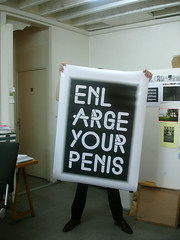In marketing/advertising we talk about changing behaviour. We speak of trends, present analysis and peer into the near horizon of our own timelines. We blog about the changing of consumer experience, discuss demographics, strategies and new ways of measuring reach, frequency and engagement. And in amongst all this conversation we are building our own edifice to social media — shouting, talking and building, word by word, our own empire. But I wonder, is this all sounding so hollow?
We are the hollow men
We are the stuffed men
Leaning together
Headpiece filled with straw. Alas!
Our dried voices, when
We whisper together
Are quiet and meaningless
As wind in dry grass
Or rats’ feet over broken glass
In our dry cellar
— TS Eliot, The Hollow Men
If we take a look at the shapes of these stimulus, if we examine the state of BEING rather than the active state of PERFORMING (in our roles of employer, employee, creator, listener, receiver, etc), then we may wonder at the particular historical moment in which we have found ourselves. The popularity and rise associated with "reality TV" shows such as Big Brother and even Eurovision only hold sway momentarily, never to be repeated in the future — for the interactivity, voting and audience involvement is as transient as the beep notification of an SMS alert.
And while our cultural artefacts are being produced at ever greater rates, the co-creation and location of their meaning appears to be increasingly bound up in the evanescent energy of this "interactivity". David Cushman, for example, cites a press release claiming that:
More video material has been uploaded to YouTube in the past six months than has ever been aired on all major networks combined, according to cultural anthropologist Michael Wesch. About 88 percent is new and original content, most of which has been created by people formerly known as “the audience".
However, as Alan Kirby points out in this article on Postmodernism (via Amanda Chappel):
A culture based on these things can have no memory – certainly not the burdensome sense of a preceding cultural inheritance which informed modernism and postmodernism. Non-reproducible and evanescent, pseudo-modernism is thus also amnesiac: these are cultural actions in the present moment with no sense of either past or future.
In the place of Postmodernism, Kirby argues for a new defining cultural moment — pseudo modernism. Identifying 1980 as the turning point, the pseudo modernists can also be seen as those generations succeeding Generation X — so called Generation Y or Millennials, though like anything, is more likely to relate to a mode of being than to an age/demographic group. Kirby’s pseudo modernists are spookily devoid of agency, caught in the neverland between the capacity to effect change and the overwhelming minutiae digital interactions:
You click, you punch the keys, you are ‘involved’, engulfed, deciding. You are the text, there is no-one else, no ‘author’; there is nowhere else, no other time or place.
But if this is the case — if the central seeding authority of the pseudo modernist is "cluelessness" — a contrasting capacity to see and act on a big picture but an inability to act as an individual (or in community), then the antidote may well lie in the social media interactions that are their cause. For while "engagement" may well mean contributing to a social action in a far off country (perhaps distributing our own agency into the network of strong and weak ties), the proliferation of "real world" meetups and the intensity around them may provide some small cause for optimism in the bleak sea of pseudo modernist reality. This desire to capture and contain the fleeting ephemera of social interaction has driven the popularity of "live blogging", the collating and curation of "favourites" via del.icio.us and other bookmarking sites and the use and sharing of photographs, videos and so on. And while the production fails (and always will) in its effort to capture the live moment, we can be in danger of focusing too much on product over process — emphasising the cultural or social aspect of end result over being in the moment.
However, I have a feeling that the artefacts of this new reality are yet to be realised for their value. For while it is easy to discount the quality, merit or even longevity of much that passes for cultural production in the current era, perhaps it is time to re-evaluate what can and should be considered important.
The disbelief in grand narratives that Lyotard identified with the postmodernists is a handy tool when it comes to thinking through our current consumer/cultural moment. And I have a feeling that Generation Y will prove to be more culturally heretical than they might at first appear. After all, the Internet with its hypertext and self-spurning evolution could well be considered the defining achievement of the postmodern generation. But the WAY in which future generations use, activate and build upon the Internet, its applications and social, technological and intellectual networks will have far reaching effects for our cultures and for us as individuals. This generation who have been "always connected" are bound to rethink society in fundamental ways.
This has certainly got ME thinking!
 If someone tells you they are a social media expert, run” — Connie Reece
If someone tells you they are a social media expert, run” — Connie Reece



